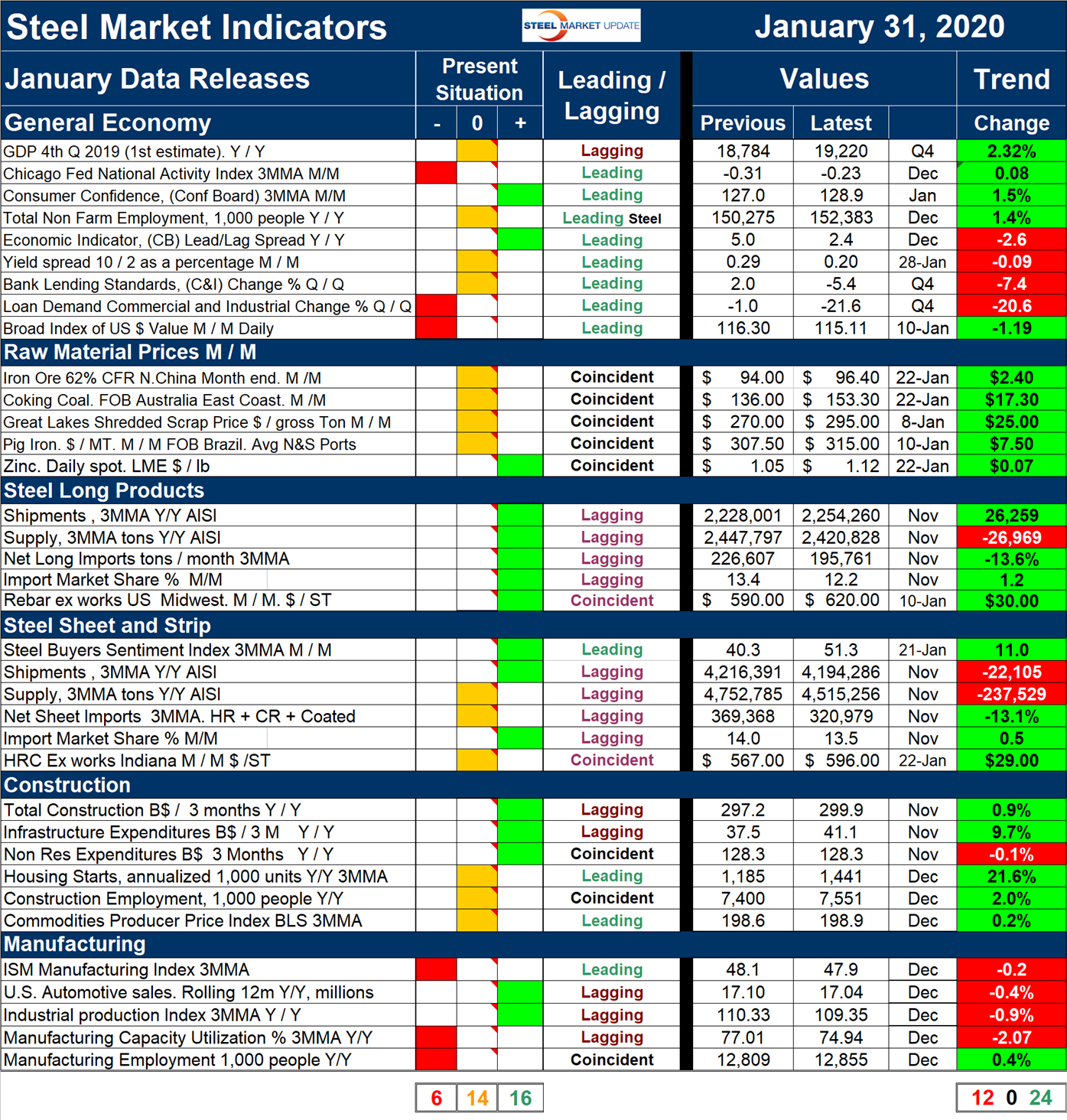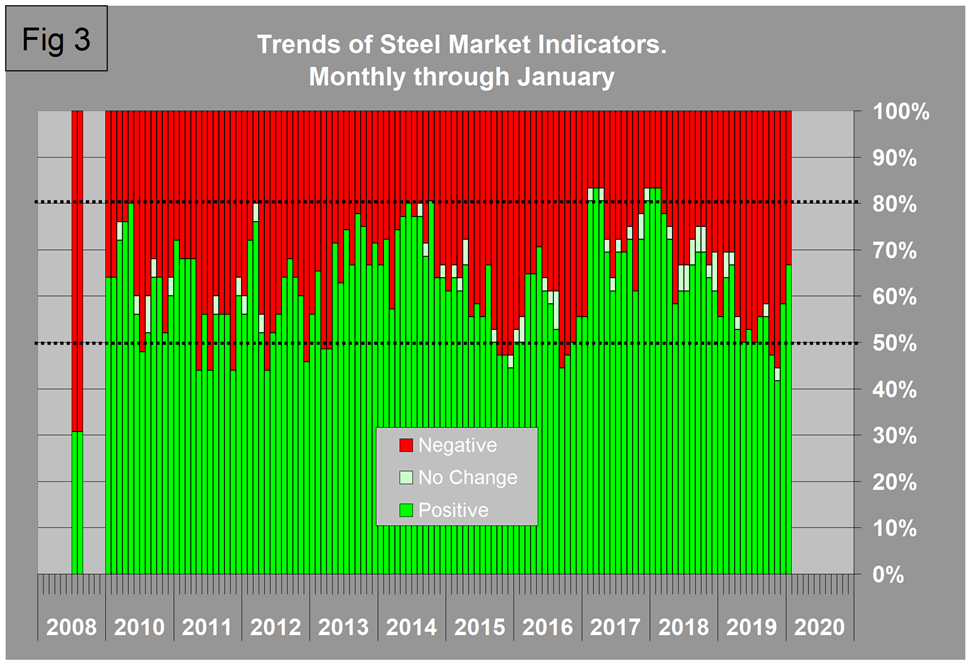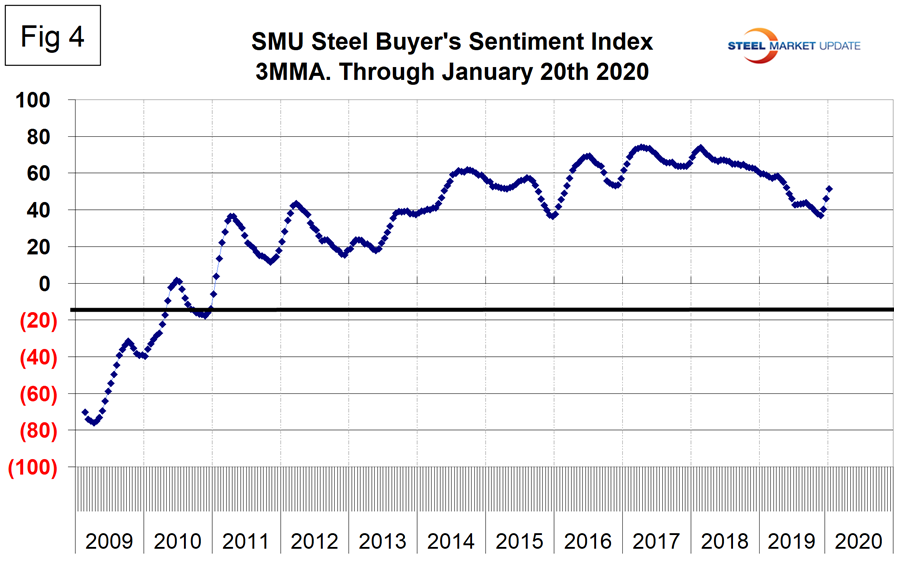SMU Data and Models

SMU Analysis: Key Market Indicators through January
Written by Peter Wright
January 31, 2020
Key Market Indicators show that the improvement in market trends that occurred in December continued into January. This report is designed to be a big picture summary of data SMU has reported in detail during the month. It summarizes 36 data streams that describe the state of the steel market and provide forward guidance for steel buyers and sellers. See the end of this piece for an explanation of the Key Indicators concept. This will explain the difference between our view of the present situation, which is subjective, and our analysis of trends, which is based on the latest facts available.
![]()
Please refer to Table 1 for our view of the present situation and the quantitative measure of trends. Readers should regard the color codes in the present situation column as a visual summary of the current market condition. The “Trend” columns of Table 1 are also color coded to give a quick visual appreciation of the direction the market is headed. All results are the latest available as of Jan. 31, 2020.

Present Situation
Our view of the January data is that the net number of indicators we regard as strong increased by two from December with 16 strong, 14 normal and 6 weak. There was a declining number of strong indicators throughout 2019, but the number we regard as weak increased only slightly. The transition was from strong to normal. The January improvement is encouraging. By normal we mean the current data value is in the mid-range of the historical distribution. Figure 1 shows the history of our view of the present situation data since January 2010 on a percentage basis, and on the far left of the chart is the August 2008 situation immediately before the recession struck the steel business in September that year. There were six individual changes in December that led to a net improvement of two positives. The price of coking coal and the volume of housing starts transitioned from negative to normal. The ISM manufacturing index and the industrial capacity utilization changed from normal to negative. The price of rebar and net long product imports changed from normal to positive. The bottom line is that in December, manufacturing continued to weaken.

We make special mention of the Treasury yield spread here because the 10-year minus two-year dipped into negative territory for three days at the end of August. Historically, a negative yield spread has been a predictor of recession within 18 months. On Jan. 28, the value was positive 0.20, which was a deterioration from 0.29 percent at the end of December (Figure 2). The negative duration was so short and the negativity so small that maybe we have dodged the recession prediction for now. The last time the 10/2 spread was negative was June 6, 2007.

There were no other changes in our view of the present situation in January.
Trends
Most values in the trends columns are three-month moving averages (3MMA) to smooth out what can be very erratic monthly data. Trend changes in the individual sectors are described below. (Please note that in many cases this is not January data but data that was released in January for previous months.)
There was a substantial improvement in market trends in December that continued in January. In December, there was a net increase of six positives; in January there was a net of three positives. This is a huge improvement in as little as two months. The number of positives increased from 15 in November to 21 in December and to 24 in January. Figure 3 shows the trend of the trends and the pre-recession situation at the far left of the chart. Five indicators reversed direction in the January data. The only trend that reversed from positive to negative was the yield spread. The prices of zinc and rebar, total construction expenditures and the producer price index of commodities all reversed direction from negative to positive in the January data. There were no trend changes for manufacturing where the only bright spot was a small increase in employment. Overall, construction is strong and manufacturing is weak.

As a reality check for this report we include here Figure 4, which is SMU’s Steel Buyers Sentiment index. Readings are developed during the twice monthly SMU market surveys. SMU Steel Buyers Sentiment is a measure of the current attitude of North American buyers and sellers of flat rolled products regarding their company’s opportunity for success in today’s market. A reading above the neutral point of zero indicates that a preponderance of buyers have a positive attitude. The index has been deteriorating since mid-February last year, but in mid-December there was a turnaround that continued through mid-January. This change is encouraging and confirms the general observations about our 36 market indicators. On a 3MMA basis, the mid-January sentiment index value was 51.33, up from 36.83 in early December but down from a peak of 73.80 in February 2018.

We believe a continued examination of both the present situation and direction is a valuable tool for corporate business planning. Figures 1 and 3 both show the pre-recession situation in August 2008. The trends analysis shows that the steel market was going over a cliff at that time, but the present values were still good with only 23 percent registering as historically negative.
Explanation: The point of this analysis is to give both a quick visual appreciation of the market situation and a detailed description for those who want to dig deeper. It describes where we are now and the direction the market is headed and is designed to describe the situation on a specific date. The chart is stacked vertically to separate the primary indicators of the general economy, of raw material prices, of both sheet and long product market indicators, and of construction and manufacturing indicators. The indicators are classified as leading, coincident or lagging as shown in the third column.
Columns in the chart are designed to differentiate between where the market is today and the direction it is pointing. Our evaluation of the present situation is subjectively based on our opinion of the historical value of each indicator. There is nothing subjective about the trends section, which provides the latest facts available on the date of publication. It is quite possible for the present situation to be predominantly red and trends to be predominantly green or vice versa depending on the overall situation and direction of the market. The present situation is subdivided into: below the historical norm (-) (OK), and above the historical norm (+). The “Values” section of the chart is a quantitative definition of the market’s direction. In most cases, values are three-month moving averages to eliminate noise. In cases where seasonality is an issue, the evaluation of market direction is made on a year-over-year comparison to eliminate this effect. Where seasonality is not an issue, concurrent periods are compared. The date of the latest data is identified in the third values column. Values will always be current as of the date of publication. Finally, the far-right column quantifies the trend as a percentage or numerical change with color code classification to indicate positive or negative direction.

Peter Wright
Read more from Peter WrightLatest in SMU Data and Models

SMU Survey: Sheet lead times ease further, plate hits one-year high
Steel buyers responding to this week’s SMU market survey report a continued softening in sheet lead times. Meanwhile, plate lead times have moderately extended and are at a one-year high.

SMU Survey: Buyers report more price flexibility from mills
Nearly half of the steel buyers responding to this week’s SMU market survey say domestic mills are showing increased willingness to negotiate pricing on new spot orders. This marks a significant shift from the firmer stance mills held in prior weeks.

SMU Survey: Buyers’ Sentiment Indices fall
Current Sentiment Index dropped six points to +42 this week compared to two weeks earlier. It has fallen in every successive survey since reaching a 2025 high of +66 on Feb. 19.

March service center shipments and inventories report
Steel service center shipments and inventories report through March 2024.

Apparent steel supply contracts in February
The amount of finished steel that entered the US market in February receded from January’s peak, according to our analysis of Department of Commerce and American Iron and Steel Institute (AISI) data.
